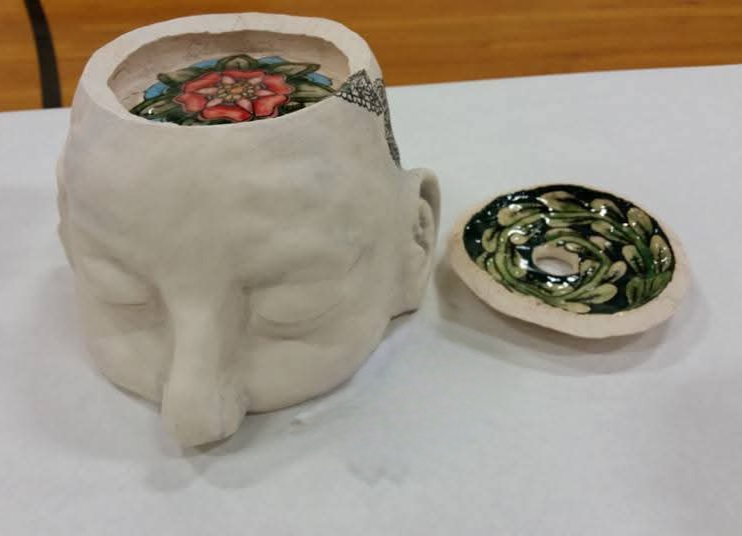Environment Within

Meet The Teacher: Jennifer LaScala
I have been teaching Ceramics 1, 2 and Independent Study at Sayreville War Memorial HS in Parlin, NJ for 20 years so far. I also am the director of Clay in Mind, a juried high school ceramics competition in NJ. I love working with clay and sharing that clay passion with my students! Cheers to Clay All Day!
Project Description
Environment Within is a project where students create a subject matter of their choice, and within that sculpture, they need to create a space of mystery or intrigue, something that will make the viewer want to look within, or at the piece for a more extended period of time.
Materials
- Amaco white art clay
- Amaco Gloss Glazes
- Amaco Watercolor Underglazes,sets 108,109,110,111
- Wooden modeling tools, soft rib tools, loop tool, pin tool, knife tool, sponge
Grade Level
High School
Difficulty
Intermediate
Student Hands-On Time
About 2 weeks,depending on student designs and project size
Teacher Prep Time
Minimal, 25-30 min
Project Cost / Cost Per Student
10
National Core Arts Standards - Visual Arts
- Creating - Generate and conceptualize artistic ideas.
- Creating - Conceiving and developing new artistic ideas and work.
- Connecting - Connect personal experiences with artmaking and meaning.
21st Century Skills
- Critical Thinking & Problem-Solving
- Creativity & Innovation
- Flexibility & Adaptability
- Initiative & Self-Direction
- Productivity & Accountability
- Leadership & Responsibility
STEAM Education
- Arts
Differentiations and Accommodations
Differentiation
IEP
Accommodation
This project works well with all levels of learners because the design is original to the artist. There's a lot more freedom in the design portion of the project,and students get to work at their own pace.
Differentiation
Advanced Learners
Accommodation
Students are creating their own subject matter for this project so it is up to them how challenging they want to make their design. Advanced learner's tend to go larger scale or create works with more sculpted details or intricate glaze work.
Learning Objectives: Knowledge
Students will understand how to create a ceramic work of art that is interesting from all angles and views of the piece. They will also understand how to create a specific area of interest and intrigue. Texture, in addition to additive details, proper construction and glaze application are always considered as well.
Learning Objectives: Skills
Students will aquire the skill of design. Students find it challenging to come up with creative, original ideas of their own. They often look towards the teacher or peers for ideas and suggestions. This project allows for them to have full and complete creativity with the subject matter, and pushes their own personal design choices a bit more.
Learning Objectives: Attitudes/Values
Sometimes students may get frustrated with the initial design portion of this project,but it's always emphasized to push themselves a little further with their designs and overall design choices,and to remain determined to create to the best of their ability. Once they solidify a design,one that is personal to themselves and that they're invested in,the truly create beautiful works of art. Some students have their art reflect their culture,their heritage or something that is near and dear to them. Others create something based off an object or location/environment.
Formative Assessment
I'm constantly walking around the classroom and have "check ins" with students to make sure they're on track. Once projects are fully completed, student fill out a project reflection rubric a self assessment and reflection on their project. We then also have a class critique and mini art gallery showing or an artist talk. For artist talk ,a student can volunteer to talk a little more about their piece or answer any questions other students might have about their artwork.
Summative Assessment
Once students have completes their project rubric reflection, I sit with them and we go over their strengths and then areas of improvement.
Reflection and Discussion
We do a class critique at the end of each project where students are given 3 post it's and must write 2 compliments and 2 pieces of advice for others. We make sure that everyone has received at least 2-3 post it's by their work. Students can choose to write their name on the post it's or remain anonymous
Lesson Activities
Design sketches/inspiration page
Students have 1-2 days to work in their sketchbooks to generate ideas and designs for their project. They find inspiration through a variety of means...ceramic books,magazines,online searching,generating lists of things they like....
Finalize design
Once students are set on a design, then finalize that design in their sketchbook and work out the process of how they're going to create it. Each student checks in with me and we talk about their design and overall concept.
Clay time!
Depending on size and difficulty of design,students have a out 1.5- 2 weeks to complete their project in wet clay
Glazing
We review as a class the different types of glazes we have in our classroom and each student considers which types of glazes work best for what they're trying to achieve visually and through color/glaze texture.
Step-by-Step Instructions
Step 1
It's hard to give step by step instructions for this lesson because there is no one single design. Students create their own original designs for the project. It's not like making a slab mug where there are particular steps in creating the cylinder and the base, and handle. This project is extremely successful because students are generating their own ideas based on the project concept of creating something of their choice and then creating an area of interest within that sculpture.


